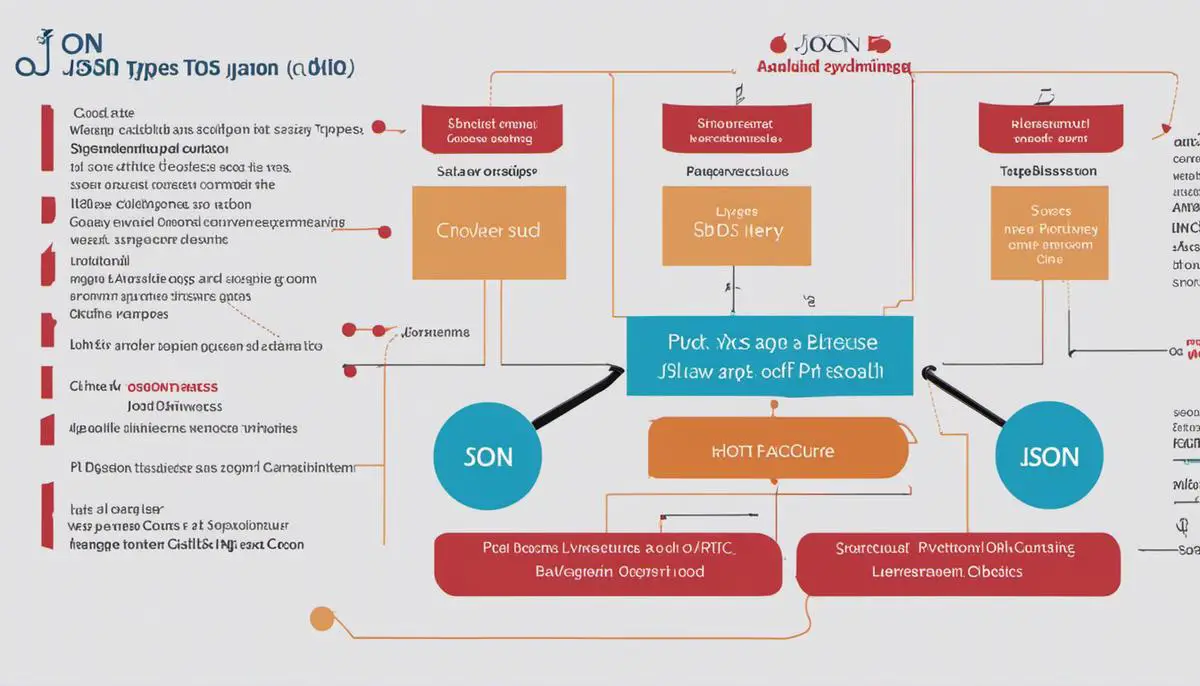Amidst the digital revolution, JSON (JavaScript Object Notation) and JavaScript are two outstanding technologies that have redefined the way we perceive, process, and represent data in the digital space. This transformative journey begins with unraveling the basics of JSON, including its syntax, data types, and formatting. Comprehending how we structure simple to complex JSON objects and utilise them to store and represent data is the key to unlocking the potential of JSON. Further, we delve into the quintessential building blocks of JavaScript, focusing on objects, arrays, and functions. This base understanding equips us with the understanding necessary to navigate through the art of parsing JSON with JavaScript.
Basics of JSON
JSON and Its Origins
JSON (JavaScript Object Notation) is a popular data interchange format that is syntactically similar to JavaScript. This data format is predominantly used for transmitting data in web applications, specifically between a server and client. JSON is known for its lightweight structure, making it a convenient option for data manipulation and data transfer in web development.
Syntax of JSON
JSON Syntax is derived from JavaScript. However, JSON is strictly data-oriented. Here are few rules that govern JSON syntax:
- Data is encapsulated in pairs of keys and values, with the keys being strings and values being valid JSON data types.
- Keys and string values must be enclosed in double quotation marks.
- JSON data should start and end with curly braces if it’s an object and square brackets if it’s an array.
- Each key-value pair in JSON objects should be separated by commas.
Data Types in JSON
Various data types are accepted in JSON format. They include numbers (integer or floating point), strings (a sequence of characters within double quotes), booleans (true or false), arrays (an ordered list of values enclosed in square brackets), objects (an unordered collection of key/value pairs), and null.
Formatting JSON
A JSON format is a string of characters containing several pieces of data. For instance, in the JSON object { “name”: “John”, “age”: 30 }, ‘name’ and ‘age’ are keys and ‘John’ and 30 are their corresponding values. If you want to add another key-value pair, it is simply a matter of appending a comma, the key-value pair enclosed in double quotes, and a colon to separate the key and the value, like this: { “name”: “John”, “age”: 30, “city”: “New York” }.
Understanding JSON Object Structure
At its most basic, a JSON object can hold a single piece of data. For example, { “color”: “blue” }. However, objects can also be complicated structures containing multiple nested objects and arrays. For instance, this JSON object contains another object for the key ’employee’, which has its own attributes: { “company”: “ABC”, “employee”: { “name”: “John”, “age”: 30, “department”: “Sales” } }.
JSON arrays contain a list of values and can hold multiple objects. For example, consider this JSON array of objects: [{ “name”: “John”, “age”: 30 }, { “name”: “Jane”, “age”: 25 }].
Usage of JSON
JSON is widely used for storing and exchanging data in today’s world of web-based applications. When data is stored in JSON format, it is in a text format, but it is used as a JavaScript object when the data is read. This conversion is seamless and takes place on-the-go in web applications. JSON objects can be created, parsed, and manipulated using JavaScript and many other modern programming languages.

JavaScript Fundamentals
Understanding JavaScript Basics: Objects, Arrays, and Functions
JavaScript, a potent programming language used mainly for enhancing web pages, utilizes several fundamental concepts, including objects, arrays, and functions. Understanding these basic principles is essential to effectively parse JSON with JavaScript.
Arrays are used to store multiple values in a single variable. These are beneficial when you wish to create a list of items. An array is defined by values separated by commas and enclosed within square brackets, like let colors = ['red', 'blue', 'green'];.
Objects, in contrast, are used to store keyed collections of various data and more complex entities. Each object consists of properties, defined as key-value pairs. An object in JavaScript can be created like this: let person = {firstName:"John", lastName:"Doe", age:50, eyeColor:"blue"};.
Functions serve as reusable blocks of code that perform a particular task. You can define a function using the function keyword, followed by a name, and then parentheses for optional parameters. For instance, function greet(name) { return 'Hello, ' + name; }.
These fundamental concepts become particularly crucial when dealing with JavaScript Object Notation (JSON).
Parsing JSON with JavaScript
JSON is a lightweight data-interchange format that is easy for humans to read and write. It’s often used when data is sent from a server to a web page. Essentially, JSON is a syntax for storing and exchanging data. In JavaScript, JSON is available as an object.
To parse JSON with JavaScript, you can use the JSON.parse() function, a built-in function that converts a JSON string into a JavaScript object. Here is an example:
let jsonString = ‘{“name”:”John”, “age”:30, “city”:”New York”}’;
let jsonObj = JSON.parse(jsonString);
console.log(jsonObj.name);
In this example, the JSON.parse() function is used to convert the JSON string into a JavaScript object. Once converted, you are able to access the data in the object using dot notation (jsonObj.name), which will output: “John”.
In conclusion, understanding JavaScript’s fundamental concepts of objects, arrays, and functions, is crucial in effectively parsing JSON data. With consistent practice, these forms of data manipulation will start to feel more familiar and intuitive.

Parsing JSON with JavaScript
Understanding JSON and its Parsing in JavaScript
JavaScript Object Notation (JSON) is a lightweight data interchange format that purposefully is easy for humans to read and write, and for machines to parse and generate. JSON is often used to transmit data between a server and a web application, or between different parts of a web application.
The JSON.parse() Method
Parsing JSON in JavaScript is achieved using the JSON.parse() method. This method takes a JSON string as input and transforms it into a JavaScript object. For example, if you have a JSON string like this: ‘{“name”:”John”, “age”:30, “city”:”New York”}’, you can transform it into a JavaScript object with the following code:
let text = '{"name":"John", "age":30, "city":"New York"}';
let obj = JSON.parse(text);
Now, ‘obj’ is a JavaScript object, and you can access the values in the JSON string like this: obj.name, obj.age, or obj.city.
Dealing with Nested JSON Objects
Sometimes, JSON objects can be nested. For instance, a JSON string might look like this: ‘{“person”:{“name”:”John”, “age”:30, “city”:”New York”}}’. In this case, you can still use JSON.parse() method to parse the JSON string into a JavaScript object. After parsing, you can access data in the ‘person’ object like this: obj.person.name, obj.person.age, or obj.person.city.
Troubleshooting Common JSON Parsing Issues
Syntax errors are a common issue when parsing JSON. This is usually caused by mistakes in the JSON string, such as missing a closing brace or comma. JSON.parse() will throw an error if it encounters any syntax errors. Interestingly, JSON strings must also be enclosed in double quotes, not single quotes, which is an often overlooked detail.
It’s important to wrap JSON.parse() inside a try/catch block to handle exceptions and avoid crashes. This will allow the application to catch and handle errors, instead of failing silently. Here is a simple example:
try {
let obj = JSON.parse(text);
}
catch (error) {
console.error('There was an error parsing the JSON: ', error);
}
With this code, if there is an error parsing the JSON, the error message will be logged to the console, informing you of what went wrong.
Remember, parsing JSON in JavaScript is not difficult, but it requires a careful attention to the structure of the JSON data and a firm understanding of JavaScript objects.

As we navigate through the realm of JavaScript and JSON, the power to parse JSON objects using the JSON.parse() method is a prominent stepping stone. Here, our focus remains on coping with typical complications that arise in this journey, such as syntax errors or the presence of nested objects. Furthermore, we learn the nuances of accessing and manipulating data retrieved from parsed JSON, leveraging this knowledge to allow digital information to be represented and processed more effectively. As we continue to explore these technologies, we embrace them as exceptional tools to navigate the modern digital landscape, bolster our technical capabilities, and above all, redefine our toolkit for digital data representation and processing.




